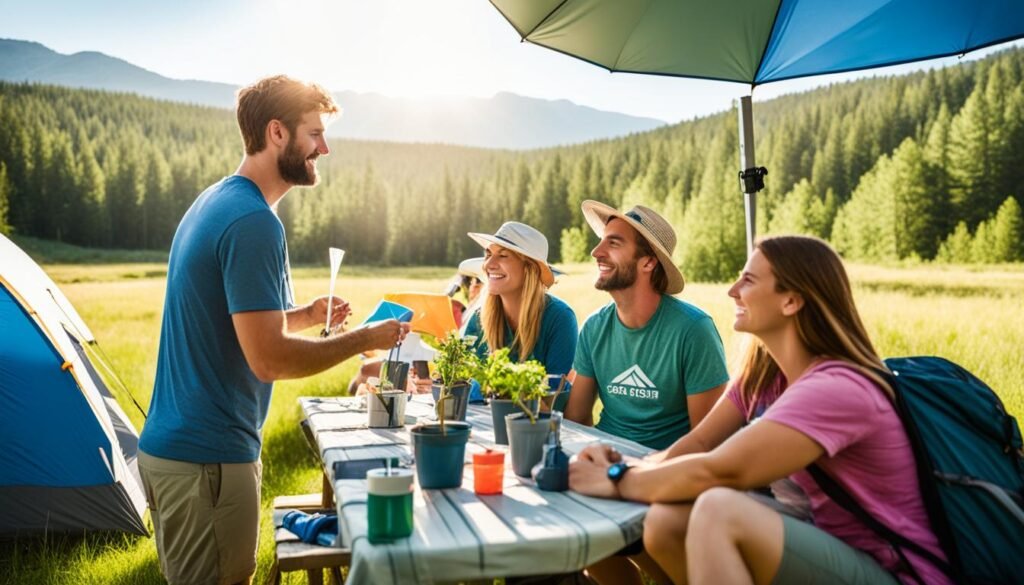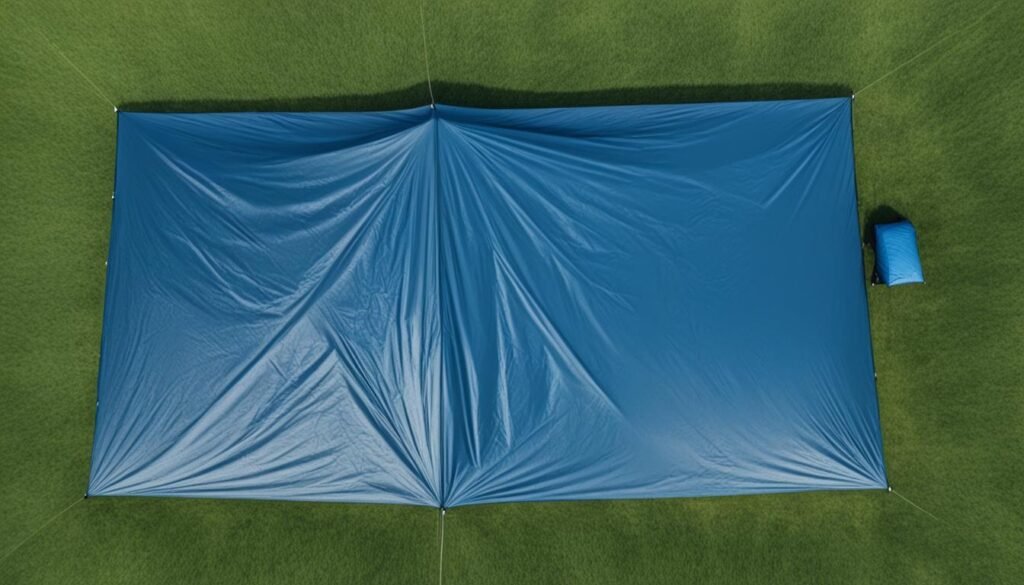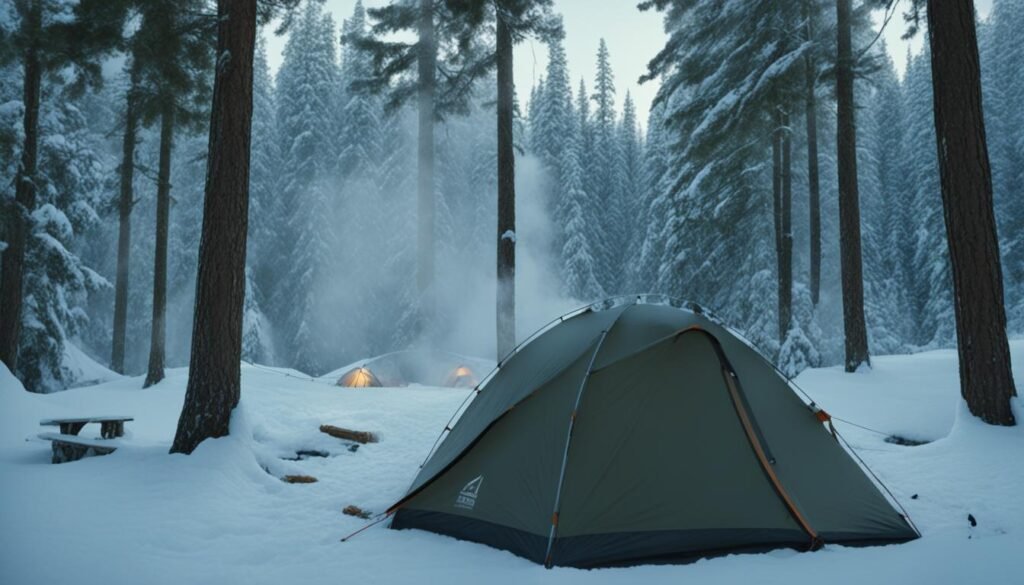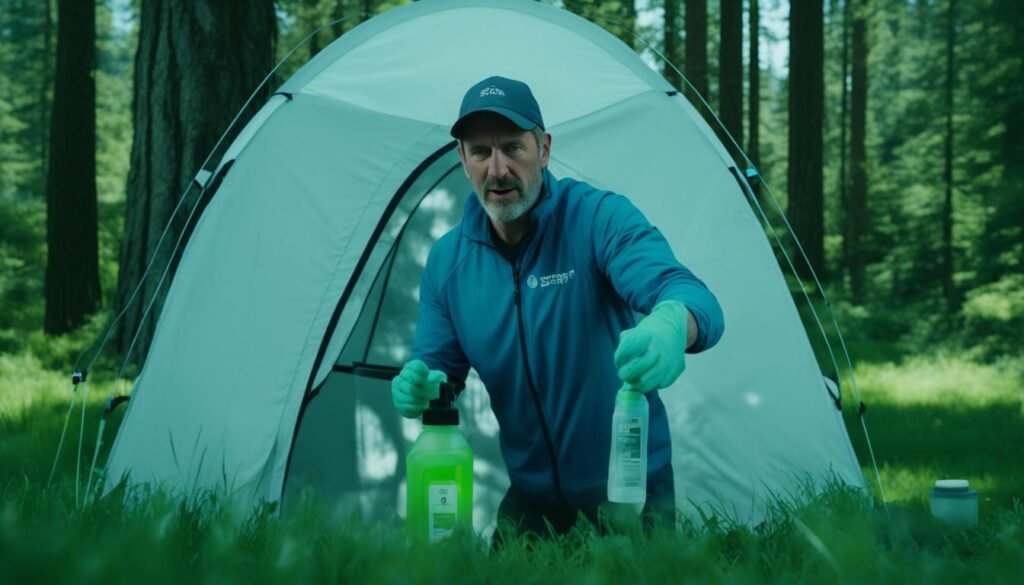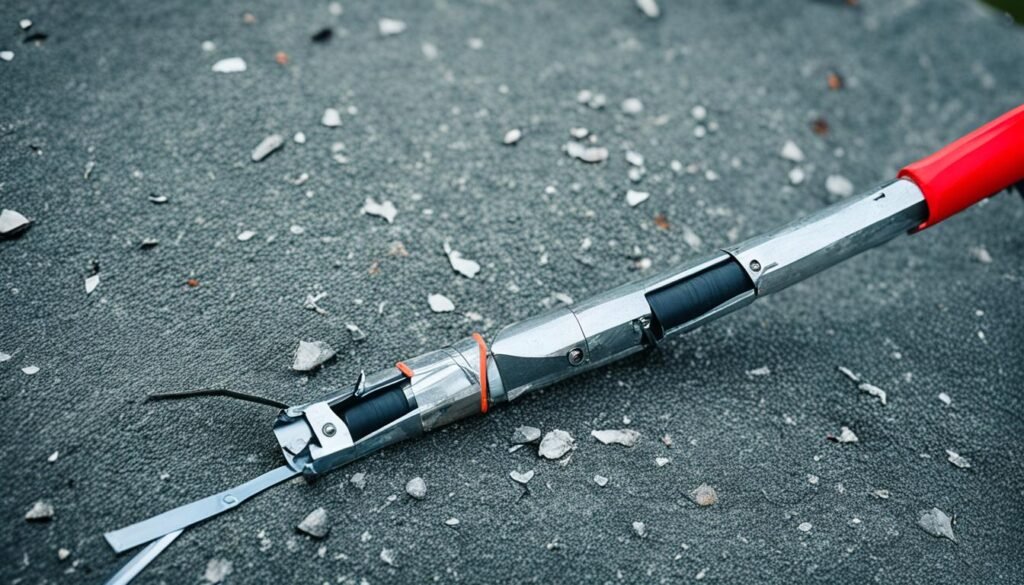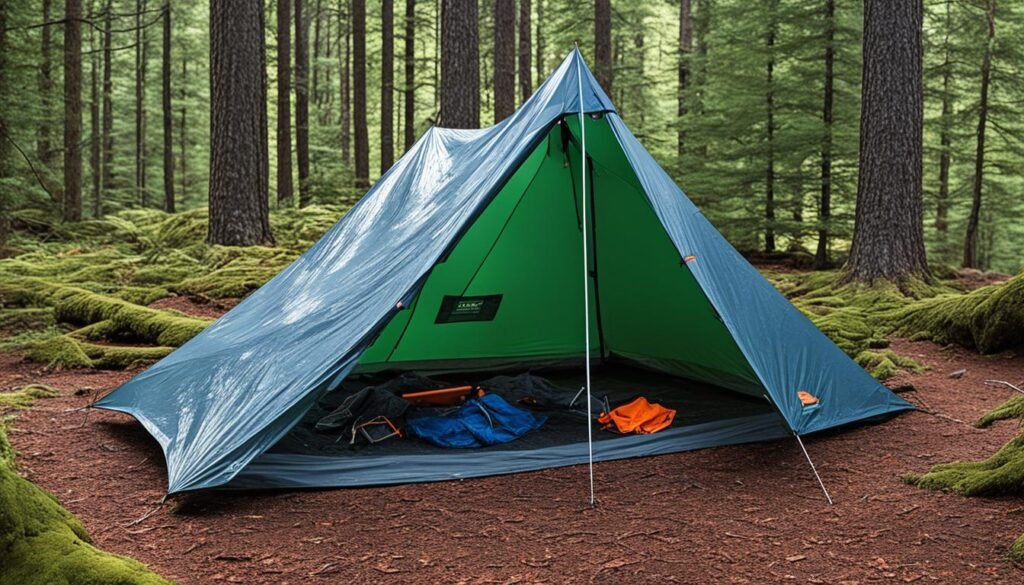Camping can be a wonderful experience, but when the sun beats down on your tent, it can quickly become uncomfortably hot. In this article, I will provide you with a variety of tips and techniques to shade your tent and lower the temperature inside, ensuring a more pleasant camping experience. From using ice coolers and battery-operated fans to choosing the right location and setting up shade canopies, these methods will help you stay cool and comfortable while camping. So let’s dive in and explore the best ways to shade a tent and keep it cool.
Key Takeaways:
- Utilize ice coolers strategically to lower the temperature inside the tent.
- Maximize airflow by utilizing the tent door and vents.
- Consider removing the rain fly to reduce heat buildup.
- Optimize your sleeping arrangements for cooler nights.
- Choose a shady location for tent setup.
Using Ice Coolers to Lower the Temperature
One effective method to lower the temperature inside your tent is to use ice coolers strategically. By placing your cooler of ice inside the tent, the chill from the ice will cool down the air, providing a more comfortable environment.
You can also take handfuls of ice from the cooler and place them in a bowl or container inside the tent to further cool the air. Additionally, you can use a battery-operated fan to circulate the air and blow the cool air out into the tent. This combination of ice coolers and fans can significantly reduce the temperature inside your tent.
“Placing ice coolers inside the tent can provide much-needed relief from the heat, ensuring a more enjoyable camping experience.” – Outdoor Adventure Magazine
Ice Cooler Tips for Tent Shade
- Choose a high-quality cooler that can retain ice for an extended period.
- Use block ice instead of cubed ice for longer-lasting cooling.
- Position the cooler strategically inside the tent to maximize airflow around the ice.
- Avoid placing the cooler directly on the tent floor to prevent condensation or water leakage.
- Ensure a tight seal on the cooler to maintain ice longevity.
- Consider using reusable ice packs for convenience and reduced water mess.
By implementing these ice cooler tips and techniques, you can effectively cool your tent and enjoy a more comfortable camping experience even in hot weather.
Utilizing Tent Door and Vents for Air Circulation
When it comes to keeping your tent cool, utilizing the door and vents for air circulation is an effective strategy. By opening the tent’s door and vents, you can allow a steady flow of fresh air to enter the tent, maximizing airflow and promoting better ventilation.
If your tent is equipped with mesh doors and vents, it’s beneficial to leave them open at all times. This not only allows for continuous airflow but also helps to keep bugs and animals at bay.
For tents without mesh, it’s recommended to open the door and vents during the day and when you’re not in the tent. This simple action prevents heat buildup and creates a cooler environment inside your tent.
Why is Air Circulation Important?
Adequate air circulation is crucial for maintaining a comfortable temperature inside your tent. Without proper ventilation, the air can become stagnant, trapping heat and humidity. This can make your camping experience unpleasant and even pose health risks.
Proper air circulation not only keeps the air cool and refreshing but also helps to reduce condensation and prevent the growth of mold and mildew. Additionally, it improves the overall air quality inside the tent, making it a more enjoyable space to relax and sleep.
“Maximizing airflow and utilizing tent doors and vents are essential for creating a comfortable and well-ventilated environment inside your tent.”
| Benefits of Utilizing Tent Doors and Vents for Air Circulation | How to Maximize Airflow in Tents |
|---|---|
|
|
Maximizing airflow and utilizing tent doors and vents are essential for creating a comfortable and well-ventilated environment inside your tent. By implementing these simple strategies, you can ensure proper air circulation, prevent heat buildup, and enjoy a cooler camping experience.
Removing the Rain Fly for Heat Reduction
One effective way to keep your tent cool is by removing the rain fly when the weather forecast doesn’t predict rain. The rain fly, typically made of thick material, can trap heat inside the tent, causing the temperature to rise. By removing the rain fly and storing it in the tent bag, you can prevent heat buildup and create a cooler environment inside the tent.
If you have a tarp or sunshade over your tent, you may not need to remove the rain fly even if it is raining. The tarp or sunshade can provide protection from rain while allowing airflow, keeping your tent cool and comfortable.
Reducing heat with rain fly removal is a simple and effective method to ensure a more enjoyable camping experience in hot weather.
Benefits of Removing the Rain Fly:
- Reduces heat buildup inside the tent
- Creates a cooler and more comfortable environment
- Allows for better airflow and ventilation
- Provides relief from the discomfort of excessive heat
Remember to check the weather forecast before deciding to remove the rain fly from your tent. If rain is expected, it’s important to prioritize keeping your tent dry and protected.
| Pros | Cons |
|---|---|
| Reduces heat and creates a cooler tent environment | Not suitable in rainy conditions unless a tarp or sunshade is used |
| Improves airflow and ventilation | May expose the tent to wind and drafts |
| Helps prevent condensation and moisture buildup | Requires additional storage space for the rain fly |
Optimal Sleeping Arrangements for Cooler Nights
Sleeping in a hot tent can be uncomfortable, but there are ways to improve your sleep experience and stay cool during the night. By making a few adjustments to your sleeping arrangements, you can ensure a better night’s rest even in the heat.
Instead of getting inside your sleeping bag, which can retain heat, try sleeping on top of it. This allows for better airflow and helps to regulate your body temperature. Additionally, if you’re camping with multiple people, be mindful of the added body heat that can increase the temperature inside the tent.
Consider bringing a sheet that you can sleep under instead of using a sleeping bag. Sheets provide better ventilation and allow for airflow, which can keep you cooler throughout the night. They also provide a lightweight and comfortable alternative to traditional sleeping bags.
By implementing these optimal sleeping arrangements, you can improve your comfort and sleep quality in a hot tent. Stay cool and wake up refreshed for another day of camping adventures.
Choosing a Shady Location for Tent Setup
When it comes to setting up your tent, selecting a shady location is key. Finding a spot that provides shade can help keep your tent cooler throughout the day, allowing for a more comfortable camping experience. Here are some tips for choosing a shady tent location:
- Look for areas under trees: One option is to set up your tent under the shade of trees. This natural canopy can provide excellent coverage and protection from the sun’s rays.
- Consider larger structures: If trees are not available, you can look for larger structures like mountains or rock formations that cast shadows. These can provide a shaded spot for your tent, especially during the peak hours of sunlight.
- Pay attention to the sun’s position: It’s important to consider the sun’s movement throughout the day. By choosing a location that will provide shade while you’re inside the tent, you can ensure a cooler environment.
- Opt for camping near water bodies: Camping near rivers, lakes, or ponds can offer relief from the heat. The proximity to water can create a cooler camping environment and provide natural shade.
By selecting a shady tent location, you can minimize heat absorption and create a more enjoyable camping experience. Remember to assess the sun’s position and take advantage of natural shade sources when finding the perfect spot for your tent setup.
Maximizing Wind Circulation for Cooler Air
Good wind circulation is essential for maintaining a comfortable temperature inside your tent. By maximizing wind circulation, you can keep the air fresh and cool, even in hot weather.
One of the first things to consider is the location of your camping spot. Look for areas with good air movement, such as near open fields or on hilltops where the wind can easily flow through. This will help create a constant breeze inside your tent.
When setting up your tent, position the door facing the wind direction. This allows the wind to enter the tent and circulate the air effectively. To determine the wind direction, hold your hand up and feel for the cold side of your hand. This will guide you in positioning your tent for maximum wind circulation.
If possible, camping near a river or lake can also help cool down your tent. The natural breezes generated by the water will aid in increasing airflow and lowering the temperature inside your tent.
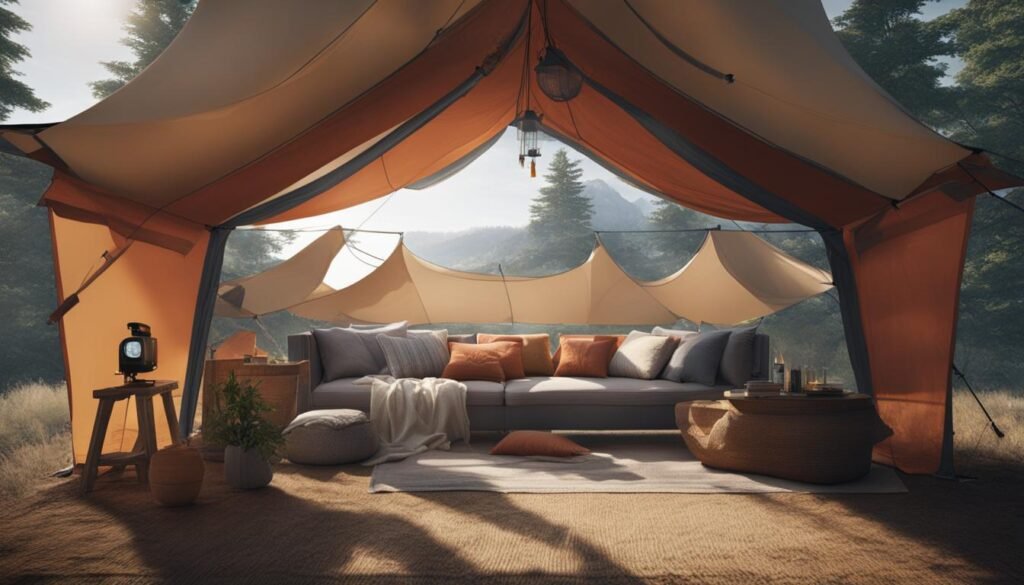
Creating an optimal airflow system within your tent is crucial for a comfortable camping experience. By maximizing wind circulation and setting up your tent in areas with good air movement, you can ensure a cool and refreshing environment.
Camp by Water for a Cooler Environment
When it comes to camping in hot weather, one of the best ways to keep your tent cool is by camping near water sources. Whether it’s rivers, lakes, or ponds, these natural bodies of water offer a refreshing coolness that can make your camping experience much more comfortable. Not only do they provide a scenic backdrop, but they also create a cooler environment by bringing down the surrounding temperatures.
By setting up your tent near the water, you can take advantage of the cooler temperatures and even catch any breezes that roll off the water. The proximity to the water helps to create a more comfortable camping environment, allowing you to escape the heat and enjoy the beauty of nature.
When selecting your camping spot, consider positioning your tent in a way that takes advantage of the cooler winds. If you’re camping near coastal waters, face your tent towards the coast to catch the breeze coming off the water. For campsites near rivers or creeks, face your tent upstream to benefit from the cooler winds flowing towards the water source.
Camping by water not only provides relief from the heat but also offers a peaceful and serene atmosphere. It’s a great way to escape the sweltering temperatures and enjoy a more comfortable camping experience.
| Benefits of Camping near Water Sources |
|---|
| 1. Cooler temperatures |
| 2. Refreshing breezes |
| 3. Serene and peaceful atmosphere |
| 4. Scenic backdrop |
Dave, an experienced camper, shares his thoughts on camping by water: “Camping near a river or lake is my go-to option during hot summer months. The coolness of the water and the gentle breeze make for a much more enjoyable camping experience. Plus, waking up to the sound of flowing water is incredibly soothing.”
Using Ground Covers to Block Ground Heat
The ground absorbs heat from the sun’s rays, which can radiate up into your tent, raising the temperature. To combat this, using ground covers such as blankets, tent footprints, or even cardboard can create a barrier between the ground and your tent, effectively preventing heat transfer. These ground covers act as insulation, keeping the heat trapped below and ensuring a cooler environment inside your tent.
In addition to traditional ground covers, you can also consider layering leaves under your tent for additional insulation. The natural properties of leaves help create an extra buffer against ground heat, further enhancing the cooling effect. This simple technique can make a significant difference in keeping your tent cool during hot weather.
By utilizing ground covers and leaf insulation, you can block ground heat and create a more comfortable camping experience. Whether you’re camping in open fields, deserts, or other hot environments, implementing these ground cover solutions will help you stay cool inside your tent.
Benefits of Using Ground Covers:
- Blocks heat transfer from the ground
- Creates a barrier between the tent and hot surfaces
- Enhances insulation and cooling effect
- Helps maintain a comfortable temperature inside the tent
With these benefits in mind, it’s clear that using ground covers is an effective method to combat ground heat and create a cooler environment inside your tent. Experiment with different types of ground covers and insulation materials to find the best option for your camping needs. Stay cool, comfortable, and enjoy your camping adventure!
Setting Up Tent at the Right Time of Day
When it comes to setting up your tent, timing is everything. To avoid the scorching daytime heat, it’s best to pitch your tent in the cooler hours of the day. Whether you choose to set it up after dark or as the sun starts to set, doing so will help prevent heat buildup inside the tent and create a more comfortable camping experience.
Before you begin, make sure to store your tent in a cool or shaded area until you’re ready to set it up. This will help keep the tent material from becoming too hot and uncomfortable to handle. For particularly hot days, consider storing your tent bag on ice to keep it as cool as possible. This extra effort will ensure that your tent is ready for setup in optimal conditions.
Setting up a tent in the dark may present some challenges, so if possible, try to set it up while there’s still some natural light during sunset. This way, you’ll have enough visibility to stake the tent and secure it properly, while still benefiting from the cooler temperatures of the evening.
By timing your tent setup correctly, you can avoid the discomfort of pitching a tent in the heat of the day and create a more enjoyable camping experience.
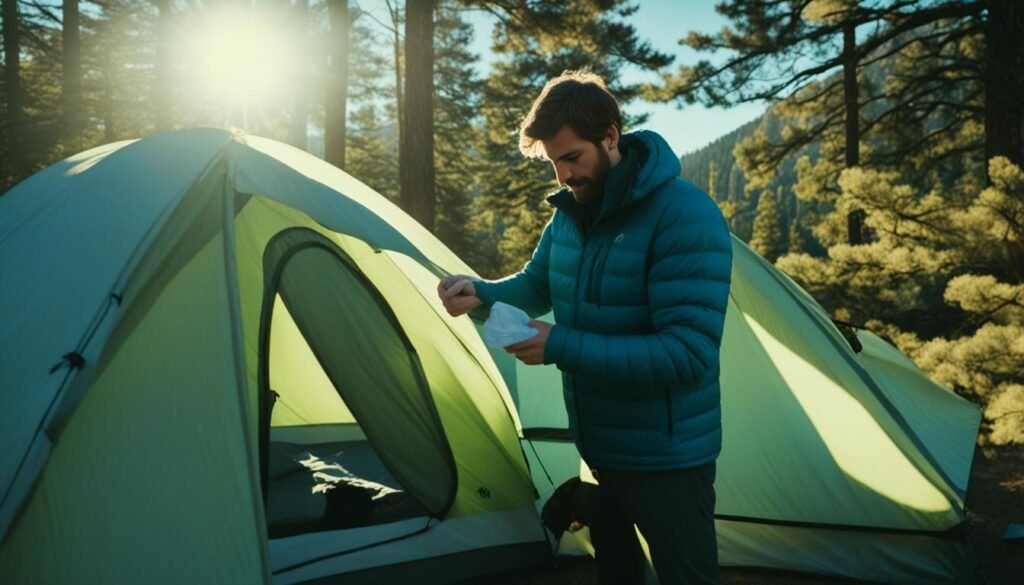
Tips for Setting Up Your Tent:
- Select a spot that offers shade, such as under a tree or against a larger structure like a mountain, to further minimize heat exposure.
- Avoid areas with direct sunlight, as they can quickly make your tent unbearably hot.
- Make sure the ground where you’re pitching your tent is clear of rocks, sticks, and debris to ensure a comfortable sleeping surface.
- Consider using a ground cover or tent footprint to provide an extra layer of insulation from the ground’s heat.
- Follow the manufacturer’s instructions for proper tent setup to ensure stability and durability against weather conditions.
Setting up your tent in the cooler hours not only helps to reduce heat buildup but also allows you to enjoy a comfortable and rejuvenating camping experience. Take the time to choose the right time of day and location for your tent setup, and you’ll be rewarded with a cooler and more inviting temporary home in the great outdoors.
Taking Down Tent During Hot Days
In extreme hot weather, it is beneficial to dismantle your tent during the day to prevent it from turning into an oven. Tents are designed to trap heat, so leaving it up can cause the temperature inside to keep rising. While it may be inconvenient to take down and set up the tent daily, doing so can significantly improve your camping experience in hot weather. Storing the tent in a cool area helps maintain its temperature, keeping it as cool as possible.
Remember, dismantling your tent during hot days is especially crucial if the temperature is extremely high. Leaving your tent standing can result in a stifling and uncomfortable camping environment. By taking it down and storing it properly, you can escape the relentless heat and enjoy a more pleasant outdoor experience.
Using Tarps or Sunshades to Block Sunlight
When it comes to keeping your tent cool and comfortable, blocking sunlight is key. Tarps, sunshades, and blankets can be incredibly effective in providing shade and preventing those harsh rays from reaching your tent. While specialized sunshades are ideal, a regular tarp or blanket can work just as well.
Position your tarp or sunshade at least 12 inches above your tent, allowing for proper airflow while still blocking the sun’s rays. This way, you can create a shaded area that reduces the temperature inside your tent, even on the hottest and sunniest days.
To set up your tarp or sunshade, securely attach it to nearby trees or use poles and stakes to create a makeshift structure. Make sure to tighten it properly to prevent any flapping or sagging that could hinder proper shade.
By effectively blocking sunlight with tarps or sunshades, you can create a cooler environment inside your tent, making your camping experience more enjoyable.
Creating Airflow with Towel Air Conditioner
When it comes to keeping your tent cool, innovative solutions can make all the difference. One such technique is using a towel air conditioner, which can provide much-needed airflow and relief from the heat inside your tent.
To create your towel air conditioner, start by dampening a thin towel, sheet, or canvas with water. Hang it at the entrance of your tent, allowing the moist fabric to capture the passing breeze and create a cooling effect as the water evaporates. This simple yet effective method can significantly lower the temperature inside your tent, providing a more comfortable camping experience.
For enhanced cooling, consider positioning a battery-operated fan near the towel. The fan will further circulate the cooled air, maximizing the cooling effect throughout the tent. With this combination of the towel air conditioner and a fan, you can create a refreshing oasis in the midst of hot weather.
Not only does the towel air conditioner offer practical benefits, but it also provides a cost-effective and environmentally friendly alternative to traditional air conditioning methods. By utilizing the natural process of evaporation, you can enjoy the cooling benefits without relying on electricity or other energy sources.
So the next time you’re camping in hot weather, don’t forget to pack a towel and a battery-operated fan. With the towel air conditioner, you can beat the heat and enjoy a cooler, more pleasant camping experience.
Towel Air Conditioner Technique:
- Dampen a thin towel, sheet, or canvas with water.
- Hang it in the entrance of your tent, allowing it to capture the passing breeze.
- Position a battery-operated fan near the towel to further circulate the cooled air.
| Pros | Cons |
|---|---|
| Provides airflow and cooling inside the tent. | Requires a battery-operated fan for enhanced cooling. |
| Cost-effective and environmentally friendly alternative to traditional air conditioning. | Relies on natural evaporation, which may be slower in humid conditions. |
| Easy to set up and requires minimal equipment. | Effectiveness may vary depending on the size of the tent and external weather conditions. |
Using Portable Fans for Better Ventilation
When it comes to improving ventilation and airflow inside your tent, portable fans are a must-have item. These battery-operated fans are not only compact and lightweight but also provide a refreshing breeze to keep you cool while camping. By strategically placing the fan near the entrance or in areas where you need additional airflow, you can maximize the circulation of fresh air within your tent.
Portable fans are designed to circulate the air, creating a breeze that helps reduce heat buildup and maintain a comfortable temperature inside the tent. Whether you’re camping in hot weather or simply need some extra airflow for better ventilation, a portable fan can make a significant difference in your camping experience.
Portable Fan Tips for Tent Airflow:
- Choose a portable fan that suits your specific needs in terms of size and power. Consider factors such as the size of your tent and the desired airflow intensity.
- Place the fan at the entrance of the tent to draw in fresh air from outside and create a cross breeze.
- If your tent has multiple ventilation windows, position the fan to blow directly towards them for better airflow.
- Adjust the fan’s speed and direction based on your comfort preferences and the temperature inside the tent.
- Ensure that the fan is securely positioned and stable to prevent any accidents or damage inside the tent.
Using a portable fan for tent ventilation not only improves airflow but also helps create a more comfortable camping environment. So, don’t forget to pack a portable fan on your next camping trip to keep cool and enjoy a refreshing breeze inside your tent.
Conclusion
After exploring a variety of tent shading techniques, it is evident that there are numerous effective methods to keep your tent cool and create a comfortable camping environment. By utilizing ice coolers and fans, you can introduce a cooling effect and lower the temperature inside your tent. Choosing a shady location, maximizing wind circulation, and camping near water sources can also provide natural relief from the heat. Additionally, using tarps or sunshades, creating airflow with a towel air conditioner, and using portable fans can significantly improve ventilation and keep your tent cool.
Whether you are camping in hot weather or simply looking to enhance your comfort, implementing these tips and techniques will help you stay cool and enjoy your camping experience to the fullest. Remember to select the best tent shading methods that suit your specific needs and preferences. By incorporating these techniques, you can beat the heat and create a pleasant atmosphere inside your tent, ensuring a more enjoyable camping adventure. So make use of these tent shading techniques and keep cool while exploring the great outdoors.
So, the next time you go camping, be prepared to keep your tent cool with these proven methods. By implementing a combination of these shading techniques, you can create an optimal environment that allows you to relax and unwind, even on the hottest days. Whether you choose to use ice coolers, maximize airflow, or camp near water sources, remember to select the methods that work best for you. With a little preparation and some practical advice, you can enjoy a refreshing and comfortable camping experience while staying cool and beating the heat.
FAQ
How can I lower the temperature inside my tent?
There are several methods you can try to lower the temperature inside your tent. These include using ice coolers, utilizing the tent’s door and vents for air circulation, removing the rain fly, making optimal sleeping arrangements, choosing a shady location for tent setup, maximizing wind circulation, camping by water, using ground covers, setting up the tent at the right time of day, taking down the tent during hot days, using tarps or sunshades to block sunlight, creating airflow with a towel air conditioner, and using portable fans for better ventilation.
How can I cool my tent with ice coolers?
Place ice coolers strategically inside the tent to cool down the air. You can also use a battery-operated fan to circulate the cool air and blow it into the tent.
How can I utilize the tent’s door and vents for air circulation?
Open the tent’s door and vents to allow fresh air to flow inside the tent and promote better airflow. For tents with mesh, keep the doors and vents open all the time. For tents without mesh, leave them open when you’re not inside the tent and during the day.
Should I remove the rain fly to lower the temperature inside the tent?
If the weather forecast doesn’t predict rain, removing the rain fly can help lower the temperature inside the tent. Rain flies can trap heat and raise the temperature. However, if you have a tarp or sunshade over your tent, you may not need to remove the rain fly even if it’s raining.
What are the optimal sleeping arrangements for cooler nights?
Sleep on top of your sleeping bag to stay cool, instead of getting inside it. Consider using a sheet for better ventilation. Also, keep in mind that body heat can increase the temperature inside the tent.
How can I choose a shady location for tent setup?
Look for spots with shade, such as under trees or in the shadow of larger structures. Consider the sun’s position and choose areas that will provide shade while you’re inside the tent.
How can I maximize wind circulation for cooler air inside the tent?
Look for camping spots with good air movement and set up your tent in an area where the wind can easily flow through. Position the tent’s door facing the wind to maximize airflow. Camping near rivers or lakes can also provide natural breezes.
Is camping near water beneficial for keeping the tent cool?
Yes, camping near water sources like rivers, lakes, or ponds can offer natural coolness. The proximity to water can create a more comfortable camping environment.
How can I block ground heat with ground covers?
Use blankets, tent footprints, or even cardboard as ground covers to create a barrier between the ground and your tent. This helps to prevent heat transfer from the ground into the tent.
What is the best time of day to set up a tent for cooler temperatures?
It’s best to set up your tent after dark or as the sun starts setting to avoid the daytime heat. Keep your tent stored in a cool or shaded area until you’re ready to set it up.
Should I take down my tent during hot days?
If the temperature is extremely hot, it can be beneficial to take down your tent during the day to prevent it from becoming an oven. Store the tent in a cool area to maintain its temperature.
How can I block sunlight from reaching my tent?
Use tarps, sunshades, or blankets positioned at least 12 inches above the tent to block the sun’s rays while allowing air to circulate.
How can I create airflow and cool down the tent with a towel air conditioner?
Dampen a thin towel, sheet, or canvas and hang it in the entrance of the tent. The moisture on the towel will evaporate, creating a cooling effect as the air passes through. You can position a battery-operated fan near the towel to further circulate the cooled air.
How can I improve ventilation with portable fans?
Use battery-operated fans in your tent to improve ventilation and airflow. Place the fan strategically to maximize airflow, such as near the entrance or where you need additional cooling.

